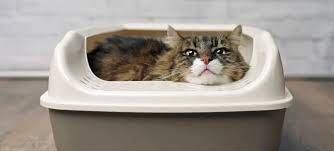Key Reasons Why Animal Waste Needs to Never Be Flushed Down the Toilet
Key Reasons Why Animal Waste Needs to Never Be Flushed Down the Toilet
Blog Article
In this article on the next paragraphs you will discover some wonderful help and advice regarding Should you flush animal waste down the toilet.

When it pertains to throwing away waste, particularly animal waste, many people commonly resort to the hassle-free option of flushing it down the bathroom. However, this relatively very easy solution can have major effects for the environment and public health. In this post, we'll discover why flushing animal waste down the bathroom is a poor concept and provide alternate approaches for correct disposal.
Introduction
Proper waste disposal is vital for keeping environmental sustainability and public health. While it may seem harmless to flush animal waste down the toilet, it can bring about numerous concerns, both for the setting and human health.
Dangers of flushing animal waste
Environmental impact
Flushing pet waste presents unsafe microorganisms and microorganisms right into rivers, which can negatively impact aquatic environments. These virus can contaminate water sources and damage aquatic life, interfering with fragile ecosystems.
Public health concerns
Animal waste includes dangerous microorganisms such as E. coli and Salmonella, which can position major health and wellness dangers to people. Purging animal waste down the bathroom can pollute water supplies, resulting in the spread of diseases and infections.
Alternatives to flushing
Rather than flushing animal waste down the bathroom, there are several different disposal techniques that are a lot more eco-friendly and hygienic.
Composting
Composting animal waste is an environment-friendly method to deal with it. By composting, organic matter is broken down into nutrient-rich dirt, which can be utilized to fertilize yards and plants.
Garbage dump disposal
Throwing away animal waste in a garbage dump is another option. While not as eco-friendly as composting, it is a safer alternative to flushing, as it stops the contamination of water resources.
Animal garbage disposal systems
There are specialized family pet garbage disposal systems readily available that safely and hygienically take care of animal waste. These systems typically make use of enzymes to break down waste and eliminate odors.
Actions to proper animal waste disposal
To make sure appropriate disposal of pet waste, adhere to click here these steps:
Scooping and landing waste
Routinely scoop and bag animal waste using naturally degradable bags. This stops waste from infecting the environment.
Using designated waste containers
Dispose of bagged pet waste in assigned waste bins, such as compost bins or landfill bins. Stay clear of flushing it down the commode in any way expenses.
Cleaning up litter boxes and pet locations consistently
Regularly tidy litter boxes and pet areas to stop the accumulation of waste and bacteria. Usage pet-safe cleaning items to keep hygiene.
Advantages of appropriate disposal approaches
Adopting correct disposal methods for animal waste uses several advantages:
Reduced environmental pollution
Appropriate disposal approaches decrease the danger of environmental pollution, shielding waterways and ecological communities from contamination
Reduced danger of water contamination.
By staying clear of flushing animal waste down the toilet, the danger of water contamination is significantly reduced, guarding public health.
Improved sanitation and health
Correct disposal methods advertise better sanitation and hygiene, creating a much safer setting for both humans and animals.
Conclusion
To conclude, purging pet waste down the commode is dangerous to the atmosphere and public health. By adopting alternate disposal techniques and following correct waste monitoring methods, we can minimize the adverse effect of animal waste and add to a cleaner, healthier world.
What To Do With Dog Poo – The Do's And Don'ts Of Disposing Of Faeces
Dog poo bins
Some councils provide dedicated dog waste bins in popular dog-walking areas that can take dog poo that has been bagged but you can legally dispose of dog waste in any public litter bin, as long as it is securely bagged. This also applies to your wheelie bin at home.
Do not flush
Water companies do not recommend flushing dog faeces down the toilet because certain parasites can survive the water processing treatment and are potentially harmful to humans. You should also never consider flushing dog poo that has been bagged down the toilet as the bags will not break down and instead create severe blockages in the sewage system.
In the woods
The Forestry Commission promotes a ‘stick and flick’ method for dealing with waste in the woods. This means finding a stick and using it to flick any poo from off the path so that it is out of the way of other walkers. You could also bury it as long as it is not in an area where there might be livestock.
Livestock
Parasites found in dog poo can be transmitted to livestock if they inadvertently eat infected faeces that has been left on grazing land. This could result in the death of sheep or abortion in cattle so you should always make sure you pick up your dog’s waste in fields where livestock could be present.

Regularly tidy litter boxes and pet areas to stop the accumulation of waste and bacteria. Usage pet-safe cleaning items to keep hygiene.
Advantages of appropriate disposal approaches
Adopting correct disposal methods for animal waste uses several advantages:
Reduced environmental pollution
Appropriate disposal approaches decrease the danger of environmental pollution, shielding waterways and ecological communities from contamination
Reduced danger of water contamination.
By staying clear of flushing animal waste down the toilet, the danger of water contamination is significantly reduced, guarding public health.
Improved sanitation and health
Correct disposal methods advertise better sanitation and hygiene, creating a much safer setting for both humans and animals.
Conclusion
To conclude, purging pet waste down the commode is dangerous to the atmosphere and public health. By adopting alternate disposal techniques and following correct waste monitoring methods, we can minimize the adverse effect of animal waste and add to a cleaner, healthier world.
What To Do With Dog Poo – The Do's And Don'ts Of Disposing Of Faeces
Dog poo bins
Some councils provide dedicated dog waste bins in popular dog-walking areas that can take dog poo that has been bagged but you can legally dispose of dog waste in any public litter bin, as long as it is securely bagged. This also applies to your wheelie bin at home.
Do not flush
Water companies do not recommend flushing dog faeces down the toilet because certain parasites can survive the water processing treatment and are potentially harmful to humans. You should also never consider flushing dog poo that has been bagged down the toilet as the bags will not break down and instead create severe blockages in the sewage system.
In the woods
The Forestry Commission promotes a ‘stick and flick’ method for dealing with waste in the woods. This means finding a stick and using it to flick any poo from off the path so that it is out of the way of other walkers. You could also bury it as long as it is not in an area where there might be livestock.
Livestock
Parasites found in dog poo can be transmitted to livestock if they inadvertently eat infected faeces that has been left on grazing land. This could result in the death of sheep or abortion in cattle so you should always make sure you pick up your dog’s waste in fields where livestock could be present.
Do you appreciate reading up on Should you flush animal waste down the toilet? Put a review directly below. We'd be glad to find out your opinion about this page. In hopes to see you back again later on. For those who appreciated our blog post please be sure to share it. I take joy in reading our article about 10 Things You Should Never Flush Down The Toilet.
Apply Now Report this page